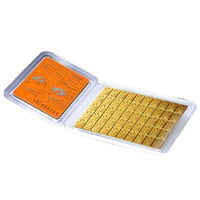Does purity matter when it comes to investing in gold? While it’s important to be able to verify...
What is the Best Entry Point for Gold?
What is the best entry point for gold?
Yesterday.
The second-best time is today.
In 2024, although inflation is starting to fall, it still remains high, and projections of economic growth are subpar. With personal finances tightening and low growth set to impact your financial stability, it is more important now than ever to employ strategies meant to preserve your wealth.
We define wealth insurance as “the store of purchasing power, with high liquidity, for a potential financial crisis you hope to never have.”
When buying gold for wealth insurance, gold brings stability to the portfolio through the preservation of purchasing power.
Yes, the price of gold will fluctuate. That is due to the fluctuation in the strength of the fiat currency you use to measure gold. The purchasing power of the currency like the U.S. is diluted as money supply is increased. It takes more currency over time to buy the same ounce of gold, but when you zoom out, gold’s purchasing power remains fairly constant over time.
It’s impossible to time the markets, but if gold is part of the core holdings of your portfolio, then the price you purchased it at doesn’t matter. What does matter is the number of ounces you own over the long-term.
Simply put, the best entry point for gold is any time you’re able to buy.

At All-Time Highs, Gold is Cheap
At all-time highs, gold is cheap.
No matter where gold goes in the next few years of this bull market, the long-term store of value will always increase. The lows of the next bear market have always been higher than the lows of previous, and the highs of each precious metals bull market break the record highs of the one before it. Going back centuries, the long-term fundamentals of gold are strong.
Even with gold at all-time highs, there is still plenty of opportunity for gold to go further from here as global geopolitical instability continues to drive safe haven buying. A material dip in the U.S. dollar helped propel gold higher in August, and the U.S. dollar is continuing to weaken. If the anticipated interest rate cut cycle begins this month, as many predict, this trend in monetary policy historically tends to be very bullish for gold and silver.
That being said, there is still a strategy to buying gold well.
In a diverse portfolio, the aim for most investors is an allocation of 10% of their portfolio in gold. And you do want to aim for lower spot prices when accumulating the ounces that will make up that 10%.
So, buy the dips, and ignore market sentiment. When gold prices fall, sentiment tends to sour, and instead of seeing it as an opportunity, many assume the worst. Don’t be like them. For every high, there will be a pullback as gold stairsteps upward over time, and those dips provide the opportunity to act.

What Left Behind Looks Like
On one of the precious metals subreddits on Reddit the other day, I noticed this post,
“Gold price keeps going up and I've been waiting for an entry point for months now
As title say, I've been waiting for an entry point since 1 ounce was priced at 2200$ but I kept listening for advice not to buy at all time high and to wait. Now it's at 2437$
Any advice?”
As someone else commented on the thread, “This is what getting left behind looks like.”
The longer investors wait to get into this bull market, the longer they are allowing spot prices to climb and leave them in the dust.
“What’s a good entry point for gold?” isn’t a bad question. My intention isn’t to shame the original post, especially because it’s a smart question to ask about any investment vehicle. The person who posted it just received bad advice and acted on that bad advice, causing them to wait and wait for a perfect entry point into the markets that doesn’t exist.
If we’re looking at recent trends, this person should have bought gold at the bear market lows between 2013-2019. If they looked for signs of a burgeoning bull market and then a pullback, then they should have bought in 2021-2022 when gold pulled into a narrow trading range after hitting highs in 2020. And now, as gold hits a new all-time high every few months, they should be buying the dips.
Gold doesn’t move in a straight line in a bull market and every dip should be seen as an opportunity.
But many investors tend to ignore solid “entry points” and miss out on taking advantage of dips in the spot price because they’re focusing on negative sentiment and short-term price movement. Gold is best viewed in long-term historical patterns, and when you zoom out, it is clear that gold steadily increases in value over time.

100-Year Historical Price Chart from Macrotrends.com
As I said before, at all-time highs, gold is cheap. We don’t know what or when the next high in gold will be, or whether in the next few years the spot prices will remain high, or fall from here. What we do know is that the bull market is well established and that the long-term fundamentals for gold are strong, then you have nothing to fear when buying gold at today’s prices.
Or tomorrow’s. Or yesterday’s.
Don’t wait to buy gold, buy gold and wait.
If not, you’re going to wish you did.




